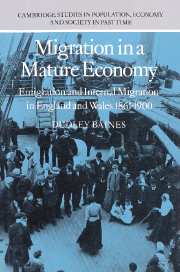Book contents
- Frontmatter
- Contents
- List of tables
- List of figures
- Acknowledgements
- 1 Introduction: the scope of the study
- 2 Issues in the history of European emigration, 1840–1914
- 3 The characteristics of British emigrants before 1914
- 4 The estimation of migration by county of birth
- 5 Return migration to Britain, 1860–1914
- 6 The birthplace of English and Welsh emigrants, 1861–1900
- 7 English and Welsh emigrants in the 1880s and 1890s
- 8 Emigration and urban growth
- 9 Rural-urban stage emigration, 1861–1900
- 10 Wales and the Atlantic economy, 1861–1914
- A summary of conclusions
- Appendices
- Bibliography
- Index
7 - English and Welsh emigrants in the 1880s and 1890s
Published online by Cambridge University Press: 24 November 2009
- Frontmatter
- Contents
- List of tables
- List of figures
- Acknowledgements
- 1 Introduction: the scope of the study
- 2 Issues in the history of European emigration, 1840–1914
- 3 The characteristics of British emigrants before 1914
- 4 The estimation of migration by county of birth
- 5 Return migration to Britain, 1860–1914
- 6 The birthplace of English and Welsh emigrants, 1861–1900
- 7 English and Welsh emigrants in the 1880s and 1890s
- 8 Emigration and urban growth
- 9 Rural-urban stage emigration, 1861–1900
- 10 Wales and the Atlantic economy, 1861–1914
- A summary of conclusions
- Appendices
- Bibliography
- Index
Summary
The relatively high rate of emigration from Britain in the 1880s has, not unnaturally, attracted considerable scholarly attention. It used to be a common view, for example, that it was the consequence of an agricultural depression and that the fall in the rate of emigration in the 1890s was because agriculture revived. This issue was examined by Charlotte Erickson in a well-known paper. She was able to show that the majority of British emigrants to the U.S.A. in the 1880s had previously lived in urban areas. She also showed that large numbers of the emigrants were unskilled workers. Professor Erickson's findings suggest that an agricultural depression was not the main cause of the emigration, but they do not prove it. Among other things, we need to know where the emigrants had been born. If the condition of agriculture was related to the rate of emigration we would expect that the number of rural-born emigrants increased in the 1880s and decreased in the 1890s.
The course of emigration in the 1880s is part of a wider issue. We can assume that more people emigrated in the 1880s because the net benefits of emigration were greater in that decade than in other decades. But were these emigrants more likely to have come from those counties from which emigration had been high or from those counties where it had been low?
The answer to this question will provide some important clues about the significance of the flow of information.
- Type
- Chapter
- Information
- Migration in a Mature EconomyEmigration and Internal Migration in England and Wales 1861–1900, pp. 178 - 212Publisher: Cambridge University PressPrint publication year: 1986

